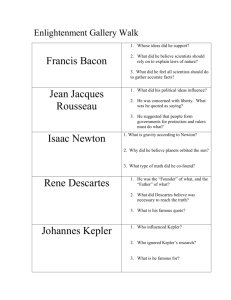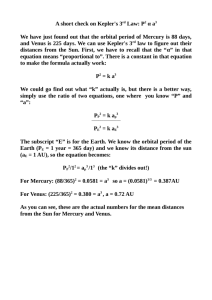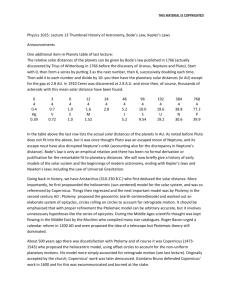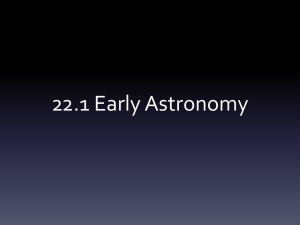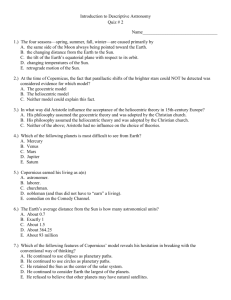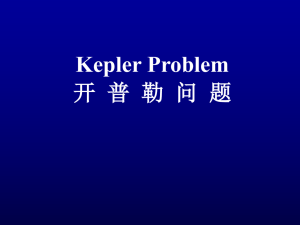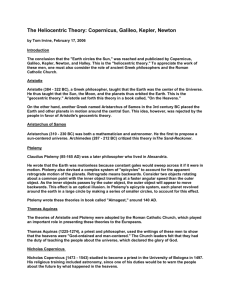Ptolemy, Copernicus, and Kepler on linear distances
advertisement
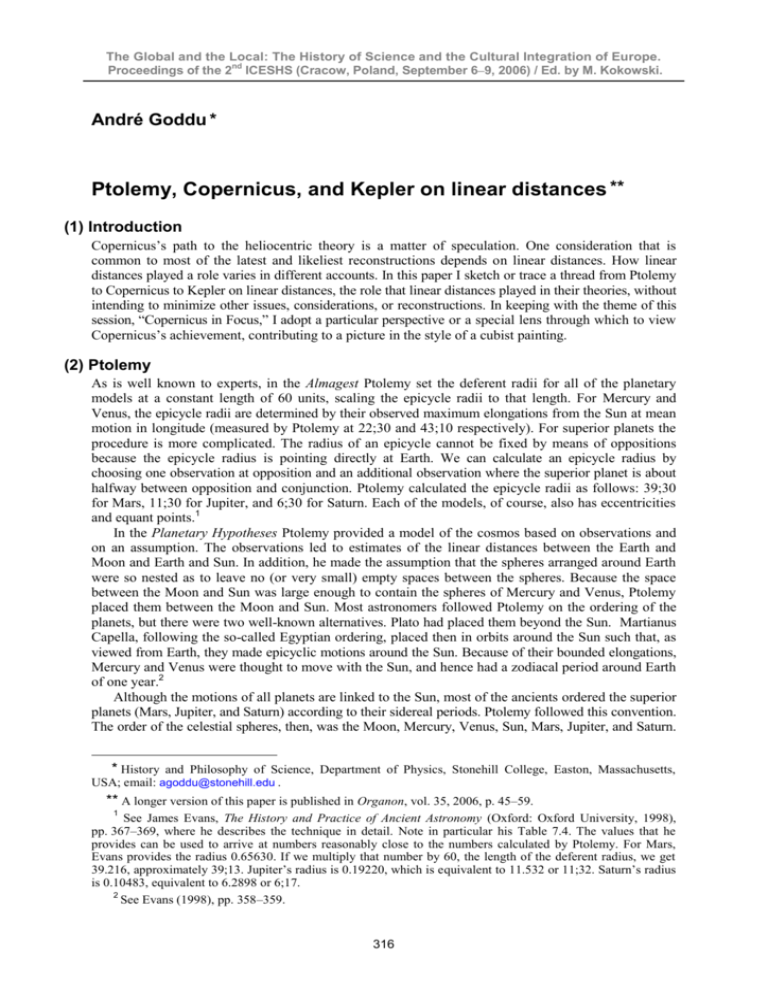
The Global and the Local: The History of Science and the Cultural Integration of Europe. nd Proceedings of the 2 ICESHS (Cracow, Poland, September 6–9, 2006) / Ed. by M. Kokowski. André Goddu * Ptolemy, Copernicus, and Kepler on linear distances ** (1) Introduction Copernicus‟s path to the heliocentric theory is a matter of speculation. One consideration that is common to most of the latest and likeliest reconstructions depends on linear distances. How linear distances played a role varies in different accounts. In this paper I sketch or trace a thread from Ptolemy to Copernicus to Kepler on linear distances, the role that linear distances played in their theories, without intending to minimize other issues, considerations, or reconstructions. In keeping with the theme of this session, “Copernicus in Focus,” I adopt a particular perspective or a special lens through which to view Copernicus‟s achievement, contributing to a picture in the style of a cubist painting. (2) Ptolemy As is well known to experts, in the Almagest Ptolemy set the deferent radii for all of the planetary models at a constant length of 60 units, scaling the epicycle radii to that length. For Mercury and Venus, the epicycle radii are determined by their observed maximum elongations from the Sun at mean motion in longitude (measured by Ptolemy at 22;30 and 43;10 respectively). For superior planets the procedure is more complicated. The radius of an epicycle cannot be fixed by means of oppositions because the epicycle radius is pointing directly at Earth. We can calculate an epicycle radius by choosing one observation at opposition and an additional observation where the superior planet is about halfway between opposition and conjunction. Ptolemy calculated the epicycle radii as follows: 39;30 for Mars, 11;30 for Jupiter, and 6;30 for Saturn. Each of the models, of course, also has eccentricities and equant points.1 In the Planetary Hypotheses Ptolemy provided a model of the cosmos based on observations and on an assumption. The observations led to estimates of the linear distances between the Earth and Moon and Earth and Sun. In addition, he made the assumption that the spheres arranged around Earth were so nested as to leave no (or very small) empty spaces between the spheres. Because the space between the Moon and Sun was large enough to contain the spheres of Mercury and Venus, Ptolemy placed them between the Moon and Sun. Most astronomers followed Ptolemy on the ordering of the planets, but there were two well-known alternatives. Plato had placed them beyond the Sun. Martianus Capella, following the so-called Egyptian ordering, placed then in orbits around the Sun such that, as viewed from Earth, they made epicyclic motions around the Sun. Because of their bounded elongations, Mercury and Venus were thought to move with the Sun, and hence had a zodiacal period around Earth of one year.2 Although the motions of all planets are linked to the Sun, most of the ancients ordered the superior planets (Mars, Jupiter, and Saturn) according to their sidereal periods. Ptolemy followed this convention. The order of the celestial spheres, then, was the Moon, Mercury, Venus, Sun, Mars, Jupiter, and Saturn. * History and Philosophy of Science, Department of Physics, Stonehill College, Easton, Massachusetts, USA; email: agoddu@stonehill.edu . ** A longer version of this paper is published in Organon, vol. 35, 2006, p. 45–59. 1 See James Evans, The History and Practice of Ancient Astronomy (Oxford: Oxford University, 1998), pp. 367–369, where he describes the technique in detail. Note in particular his Table 7.4. The values that he provides can be used to arrive at numbers reasonably close to the numbers calculated by Ptolemy. For Mars, Evans provides the radius 0.65630. If we multiply that number by 60, the length of the deferent radius, we get 39.216, approximately 39;13. Jupiter‟s radius is 0.19220, which is equivalent to 11.532 or 11;32. Saturn‟s radius is 0.10483, equivalent to 6.2898 or 6;17. 2 See Evans (1998), pp. 358–359. 316 CHAPTER 12. / Symposium R-4. Nicholas Copernicus in focus The sizes of the spheres were calculated in the following way.3 The Moon‟s distance from Earth was thought to vary between 33 Earth radii (ER) and 64 ER. The Sun‟s distance was calculated to be between 1160 ER and 1260 ER. Mercury‟s minimum distance was the Moon‟s maximum distance, 64 ER. Ptolemy calculated Mercury‟s maximum distance by multiplying 64 by the ratio of greatest to least distance. The calculation of the greatest distance comes approximately from the addition of the deferent radius (always 60) plus the epicycle radius plus the eccentricity. The least distance comes from the deferent radius minus the epicycle radius minus the eccentricity. For example, Mercury‟s greatest distance is 60 + 25 + 3 = 88. The minimum distance is 60 – 23 – 3 = 34. Therefore, the ratio of greatest to least is 88 : 34. Multiply 64 by 88 / 34, and you get 166 ER as the maximum distance for Mercury. And so on with each sphere. (3) Copernicus Copernicus himself suggests that he was obsessed with the failures of his predecessors, inconsistencies among astronomers about the ordering of the planets, and puzzles related to variations in the distances of the planets relative to Earth. Some experts have insisted that strictly astronomical and mathematical considerations led him to the heliocentric theory, but in my view it was qualitative, not technical, mathematical issues that led him to adopt heliocentrism with its geokinetic consequences.4 The technical mathematical parts show that the results are roughly equivalent to Ptolemy‟s mathematical models. In other words, his major innovation was cosmological (heliocentric and geokinetic), for which merely qualitative mathematical considerations sufficed. In Commentariolus (ca. 1510) Copernicus tells us that he accepted the ancient assumption that the motions of the heavenly bodies are to be accounted for by using spheres that move uniformly. As anomalies arose, combinations of circles were introduced and became more complicated, and finally circles were postulated that violated the principle of uniform motion relative to their deferent spheres and even their own epicycle centers. As a consequence, he began to search for a more reasonable arrangement of circles that would account for every apparent irregularity without violating the principle of uniform motion with respect to a sphere‟s proper center. At this point, his account becomes vague, informing us that somehow he hit on models that worked better, provided one accepted his seven postulates. It is likely that Copernicus was bothered by several problems. His objection to the equant model did not lead to the heliocentric theory.5 But that problem did lead him to focus on other irregularities in the motions of the spheres, the varying distances of the planets, and the disagreements in the ordering of the planetary spheres.6 Copernicus‟s acquaintance with Regiomontanus‟s Epitome of Ptolemaic astronomy (1496) allowed him to compare a variety of models and to examine alternatives, and to do so while concentrating initially only on the lengths of the radii of spheres.7 In the course of comparing alternatives, he encountered or 3 See Evans (1998), pp. 384–392. The most important representative of the technical, mathematical route to heliocentrism, of course, is Noel Swerdlow, “The Derivation and First Draft of Copernicus‟s Planetary Theory,” Proceedings of the American Philosophical Society, vol. 117, 6 (1973), p. 423–512, esp. pp. 425–431 and 470–478. For a defense of the more qualitative analysis, see Bernard Goldstein, “Copernicus and the Origin of His Heliocentric System,” Journal for the History of Astronomy, vol. 33 (2002), p. 219–235. Martin Clutton-Brock, “Copernicus‟s Path to His Cosmology: An Attempted Reconstruction,” Journal for the History of Astronomy, vol. 36 (2005), p. 197–216, also defends the more technical approach, but he also introduces several intermediate steps and considers external circumstances. See also my “Reflections on the Origin of Copernicus‟s Cosmology,” Journal for the History of Astronomy, vol. 37 (2006), p. 37–53. I also agree with many of the considerations in Michał Kokowski‟s monograph, Copernicus’s Originality. Towards Integration of Contemporary Copernican Studies (Warsaw – Cracow: Wydawnictwa IHN PAN, 2004), pp. 37–49. 5 As Goldstein (2002), p. 220, rightly emphasizes. 6 Some of these complaints appear in Commentariolus; they are all clearly laid out in De revolutionibus I, 4. 7 See Joannes Regiomontanus, Epytoma Joannis de monte regio In almagestum Ptolomei (Venice, 1496), facsimile in Opera collectanea, ed. Felix Schmeidler, Milliaria, X, 2 (Osnabrück: Otto Zeller, 1972). Copernicus did not know Ptolemy‟s Planetary Hypotheses, but he could have derived the distances for the Moon and Sun and the ratios of least to greatest distance from Regiomontanus‟s Epitome, V, 20–21; IX, 1 and 19; X, 3, 18, and 4 317 André Goddu Ptolemy, Copernicus, and Kepler on linear distances recalled the Capellan arrangement that necessarily placed Mercury closer than Venus to the Sun. That arrangement would have instantly suggested an explanation of (and not just account for) the observation of their bounded elongations. At this point, he may have calculated their sidereal periods, although it is also possible that he saw at once that if Earth were in the third orbit, the result would be the same. Despite errors in some of his calculations, he saw that the sidereal periods for both Mercury and Venus were less than the Sun‟s sidereal period.8 What struck Copernicus is the fact that the ratios of maximum to minimum distances for Venus and Mars are more than twice as large as those for any other planet. That fact combined with uncertainty about the ordering of the planets prompted him to consider alternatives. Ptolemy‟s lunar model inadvertently predicted that the Moon should double in size at the quadrature points. Copernicus‟s double-epicycle lunar model avoided that consequence, but his solution did not necessitate heliocentrism. What struck Copernicus about Ptolemy‟s planetary epicycle models were principally three facts. First, all of the epicycles are large, and those for Venus and Mars are huge in comparison to the others. The epicycle for Mars is larger than that for the other superior planets because its retrograde arcs are the widest. The size of the epicycle for Mars also reflects the fact that its variations in distance are more than twice as great as those of other superior planets. Venus‟s retrograde arc is larger than Mercury‟s. Second, it struck Copernicus as obvious that Ptolemy‟s circles have no unique center. Aside from the eccentric and equant models, the planets move around a point in such a way as to create the loops that account for retrograde motion. Third, the especially large variations in distance of Mars from Earth suggested to Copernicus that its approach and withdrawal from Earth could be caused in part by Earth‟s motion. The phenomenon of bounded elongation means that Venus and Mercury must be closer to the Sun. Because Venus‟s retrograde arc is larger than Mercury‟s, he placed Earth‟s orbit between the orbits of Mars and Venus. With Earth in a position between Venus and Mars, it would at times approach each planet and at other times withdraw from each planet. Knowing, as he did, the sidereal periods for Mars, Jupiter, and Saturn, and with his focus on the sizes of their radii relative to the Sun, he realized that Earth with its Moon would fill the gap between Venus and Mars. He then made the switch between Earth and Sun definite, placing Earth between Venus and Mars, and committed himself to the distance-period principle, that is, the distances correspond to the period of orbit. That settled the question about the order of the spheres.9 23; and XI, 7 and 16. Also, these or similar numbers appear in the theorica literature. See Campanus of Novara and Medieval Planetary Theory, Theorica planetarum, ed. Francis Benjamin Jr. and G. J. Toomer (Madison, Wisconsin: University of Wisconsin, 1971), pp. 356–363. I use Ptolemy‟s numbers as tabulated by James Evans for the sake of convenience. See Evans (1998), pp. 387–388. 8 Copernicus calculated the sidereal period of Venus to be nine months (270 days) instead of seven-and-ahalf months (225 days), and of Mercury to be 80 days in De revolutionibus I, 10, instead of 88 days, as he has it in Commentariolus. See Commentariolus, rev. translation and ed., Edward Rosen, Complete Works, Vol. 3: Minor Works (Warsaw: Polish Academy of Sciences, 1985), p. 89. See Goldstein (2002), p. 230, for his reconstruction of how Copernicus could have calculated the sidereal periods from the synodic periods. For the synodic periods, Copernicus could have calculated the numbers from Regiomontanus‟s Epitome, IX, Proposition 4, pp. 194–195 in the modern facsimile. For Venus he could have gotten a value of 584.4 days. Regiomontanus, p. 195, says that Venus has five revolutions in eight solar years. 8/5 = 1.6, 1.6 x 365.25 = 584.4. Mercury has 145 revolutions in 46 solar years. 46/145 = 0.317, 0.317 x 365.25 = 115.78 days. For a more technically precise and detailed comparison, see Noel Swerdlow and Otto Neugebauer, Mathematical Astronomy in Copernicus’s De Revolutionibus (New York and Berlin: Springer Verlag, 1984), I, pp. 471–479; II, p. 539, Table 12. Swerdlow and Neugebauer compute the mean distances for all of the planets from the Sun in terrestrial radii: Mercury = 430, Venus = 822, Earth = 1142, Mars = 1736, Jupiter = 5960, and Saturn = 10477. As they point out, Copernicus reduced the scale of the planetary system. On the other hand, because the epicyclets are so small, the spaces within the spheres are greater. The space between Saturn‟s sphere and the fixed stars is indeterminate, but it has to be large enough to explain the absence of stellar parallax. 9 The ancients had calculated the sidereal period for Mars as 1.88 years, for Jupiter approximately twelve years, and for Saturn approximately thirty years. These numbers were available in Giorgio Valla, De expetendis et fugiendis rebus (Venice, 1501), f. sig. bb7v, lines 12–13, a copy of which we know Copernicus used. The copy that he used has unfortunately disappeared. 318 CHAPTER 12. / Symposium R-4. Nicholas Copernicus in focus Because the stars (sidereal periods) became the reference for the motions of the planets, he committed himself to an axial rotation of Earth, putting the fixed stars to rest.10 Finally, he adopted a number for Earth‟s orbital radius (25 units), using it in Commentariolus to scale the radii of the planetary spheres.11 Believing the apsides to be invariable, he thought a concentric system using double-epicycle models would work. From Regiomontanus‟s Epitome III, Proposition 13, he could have concluded that the apsidal line moves, which he may have confirmed by observation in 1515 and a calculation in 1516. 12 In 1515 a Latin edition of the Almagest was printed, which provided him with more useful data. In any event, the discovery of the variability of the apsides led him to question double-epicycle models for the planets, retaining the double-epicycle model only for the Moon and settling on single-epicycle, eccentric models for the superior planets.13 With respect to strictly natural-philosophical or physical assertions in support of Earth‟s motions, perhaps his most important conclusion was his rejection of Aristotle‟s assumption that elemental motion is a simple motion. To Copernicus that assumption was obviously arbitrary and a case of assuming what has to be proved. Copernicus‟s understanding of the principle of relativity of motion made it clear that the motions that we observe are appearances, and that without a privileged position or some fixed point of reference, we cannot tell whether Earth or Sun is moving. Copernicus‟s reasons for assuming Earth‟s motions, however, are partly astronomical and partly cosmological. He devised the physical arguments after concluding that Earth moves. Once he adopted its axial rotation, then it was clear that heavy bodies have a compound, not a simple, motion as they fall.14 10 In De revolutionibus, Copernicus argues for Earth‟s axial rotation before arguing for its orbital motion, but that may have been a rhetorical strategy designed to coax readers towards acceptance of its orbital motion. We do not know which he adopted first. 11 See Swerdlow, “Derivation,” p. 442 for an explanation of Copernicus‟s simplification of 26;28 to 25. For interpretations of the numbers, see Swerdlow, “Derivation,” pp. 478–480, 492–493, and 505–509; Edward Rosen, Commentariolus, p. 107, n. 169; and Ludwik Birkenmajer, Mikołaj Kopernik (Cracow, 1900), pp. 202– 210. The interpretation of the numbers and especially of the word “eccentricitas” from the upper part of the folio is very complicated. Suffice it to say here that I have adopted Birkenmajer‟s and Rosen‟s simpler analysis of “eccentricitas” and the ratios. It is Noel Swerdlow, however, who has explained the origin of the numbers and how Copernicus used them to construct his models. According to Swerdlow, the numbers for the “eccentricities” are the sines of the maximum equations of the anomaly when the epicycle in Ptolemy‟s model is at mean distance from the Earth and are proportional to the radii of the epicycles for each planet: Mars = 41;10; Jupiter = 11;3; Saturn = 6;13; Venus = 46; Mercury = 22;5. Swerdlow‟s interpretation of “eccentricitas” and the origin of the numbers reproduces the effect reported by Regiomontanus, Epitome XII, 1–2, where the radius of the planetary epicycle on a concentric is proportional to the eccentricity of the epicycle model on the equivalent eccentric model. In Copernicus‟s models, the radius of the epicycle is roughly equivalent to Earth‟s orbital radius. In effect, the Earth‟s orbital radius compensates for the large epicycles in Ptolemy‟s models. Because Copernicus shifted from a constant value for the planetary orbital radius at the top of the folio to a constant value for Earth‟s orbital radius at the bottom of the folio, he compared a planetary orbital radius to an eccentricity equal to Earth‟s orbital radius with a planetary orbital radius to Earth‟s orbital radius, that is, R : e = RP : RE, where R designates the deferent radius (10000 units), e the eccentricity of the planetary model (equivalent to the epicycle radius at mean distance and to Earth‟s orbital radius scaled to 10000), RP the planetary orbital radius, and RE the Earth‟s orbital radius (25 units). 12 See Swerdlow, “Derivation,” p. 430, for the details, but he dismisses the possibility of using the observations to set a latest date for the composition of the Commentariolus. On the observations of the Sun at the equinoxes in 1515, see Marian Biskup, Regesta Copernicana, Studia Copernicana, Vol. 8 (Wrocław: Polish Academy of Sciences, 1973), p. 65, no. 98, and p. 66, no. 99, a calculation made presumably on the basis of an observation. As for the calculation of spring equinox in 1516, see p. 99, no. 102; it could not have been based on an observation of the Sun, for it occurred at 4 a.m. 13 Venus has an eccentreccentric without an epicycle, and Mercury an eccentreccentric with an epicyclet, but the function of the epicyclet in the model for Mercury has a different function from those in the models for the superior planets. See De revolutionibus V for the planetary models. 14 See De revolutionibus I, 8. 319 André Goddu Ptolemy, Copernicus, and Kepler on linear distances With those brief comments, let me return, then, to the cosmological considerations, as expressed in De revolutionibus I, 4. The celestial spheres move in circles and move the bodies in them. Copernicus proceeds to enumerate difficulties with these general principles.15 The numerous celestial spheres have many motions with the daily motion of the entire universe the most conspicuous. Second are the proper motions of the Sun, Moon, and five planets, which motions differ from the daily motion in many ways. They move west to east through the zodiac obliquely to the equator; they appear to move non-uniformly in their orbits (first anomaly); the planets retrograde at times (second anomaly) and vary in latitude, sometimes nearer to Earth and at other times farther away. A single orb cannot cause the observed non-uniformities. Their motions are uniform but appear non-uniform to us. There are two possible causes. Either their circles have poles different from Earth‟s or the Earth is not at the center of the circles on which they revolve. The planets vary in distance, and their motions appear non-uniform in equal times because of their varying distances. He implicitly concludes that the planetary circles cannot have poles different from Earth‟s, hence Earth cannot be the center of the circles on which they revolve. In the subsequent chapters he draws the following conclusions.16 The motions of Earth cause the regular non-uniformities and variations in distance, thus eliminating or explaining some of the most peculiar non-uniformities. As for his belief that the motions of heavenly bodies are circular or composed of circles, he is anticipating Earth‟s motions. Earth‟s rotation on its axis eliminates the diurnal rotation of the entire universe. Earth‟s annual motion around the Sun explains the regularity of the seasons, the direct motions of all of the planets, and the planets‟ varying distances from Earth. In short, he is far from mentioning the complications of the geometrical models but is rather content here to insinuate the Earth‟s motions as providing an initial approximation of the solutions and explanations of the observed nonuniformities.17 To summarize the observational data, then, we need refer only to the following. The distances of the planets from Earth vary. For the planets that move with the Sun in the geocentric system, Venus‟s retrograde arc is greater than Mercury‟s. For the planets seen in opposition, the variation and the size of the retrograde arcs are greater the closer the planet is to Earth.18 In other words, Mars exhibits the greatest variation and Saturn the least. Next, Copernicus knows that the Capellan arrangement explains the observation of bounded elongation. By calculating the sidereal periods of Mercury and Venus from their synodic periods, he realizes that Venus‟s sidereal period is more than Mercury‟s and less than the Sun‟s. When he places Earth where the Sun is, the entire system falls into place. Even geocentrists had concluded that Mars, Jupiter, and Saturn follow the distance-period principle, yet the periods for Mercury and Venus were measured by the zodiacal period of the Sun, one year. That is the case if one places the Sun in the middle between the inferior and superior planets. But if one places Earth between the inferior and superior planets, then all of the planets follow the same principle. The reason for the variations in distance, in the sizes of the retrograde arcs, and the sizes of the planetary epicycles in the Ptolemaic system becomes clear. Earth is a planet, and the planets are arranged according to their sidereal periods. (4) Kepler As I turn to Kepler, I focus in particular on the initial parts of Astronomia nova, and how they established a pattern for Kepler‟s ideas about hypotheses and his use of data. His supposed need to lead his readers with him down every false path overlooks the dialectical and rhetorical purpose behind the trouble that he took to review all problems and survey all of the solutions, demonstrating their shortcomings. 19 Astronomia nova also shows that Kepler‟s results depended on assumptions from physical forces.20 15 I resort here and below to a paraphrase of Rosen‟s translation and the original by way of summary. See De revolutionibus, I, 5 and I, 9–11. 17 In fact, in De revolutionibus V, 4, Copernicus proposed three alternative geometrical models for the superior planets‟ motions around the Sun. Copernicus adopted a more pragmatic view of geometrical models than is sometimes thought. 16 18 Those facts alone might suggest that Earth is closest to Venus and Mars, as Copernicus emphasizes near the conclusion of I, 10. 19 See Johannes Kepler, New Astronomy, tr. William Donahue (Cambridge: Cambridge University, 1992), especially his remarks on p. 4: “Kepler‟s intention, as is shown in chapter 6, was to establish the perfect 320 CHAPTER 12. / Symposium R-4. Nicholas Copernicus in focus From his earliest known work on astronomy, the Mysterium cosmographicum (1596), Kepler began searching for the reasons or causes for the unique arrangement of the planets. Second, he concluded from Tycho Brahe‟s calculation of cometary parallax that the celestial spheres assumed by Copernicus were non-existent. If there are no spheres, then what moves the planets and Earth‟s moon around on epicycles and in their orbits? Of course, there was the alternative Aristotelian explanation of intelligences as movers of the planets. Kepler considered that explanation and retained a moving soul in his theory, but he quickly developed a suspicion about bodies moving in circles around geometrical points where no body is located. That is to say, “epicycles no longer made sense, because they were no longer supported by any substance.” 21 He also continued to use the geometrical devices for several years, but by 1596 he was already thinking of forces and speculating that the Sun may somehow be a partial cause of the planets‟ motions, and that each of the planets has its own mover.22 We have to be careful about Kepler‟s reliance on physical causes. For one thing, Kepler continued to appeal to formal causes in a roughly Aristotelian sense.23 Second, he did not deduce his laws or results from his assumptions about physical causes. After he discovered the laws, he tried to show how they follow from his assumptions about physical forces. His search for a physical explanation, like several other assumptions, played a crucial role in his evaluation of Copernicus‟s theory and in his critique of geocentrism. Recent studies of Kepler have been largely in agreement about the role of physical principles in guiding Kepler to his results.24 In every account there is a different emphasis, but none discounts the importance of theory and physical principles in guiding Kepler to every conclusion and his major results. If the assumptions were right, Kepler believed, then the numbers should work out in detail.25 In the Mysterium cosmographicum Kepler obtained results that led him to suspect that Copernicus made minor errors in the values for the eccentricities and radii of the orbits. This is why Kepler needed Brahe‟s values for eccentricities and radii. Precisely because Kepler was searching for a physical solution, he concluded that the line of apsides for all of the planets should pass through the body of the Sun, that is, the true Sun and not the mean Sun as in Copernicus‟s theory.26 What Kepler seized on was a peculiarity in Copernicus‟s theory, that feature of it which was a remnant of geocentrism. Copernicus‟s theory continued to grant Earth a privileged position. The deferent center of all planetary orbits is eccentric to the center of Earth‟s orbit. The center of Earth‟s orbit is the mean Sun, not the true Sun, yet Copernicus referred all motions to the mean Sun, that is, the line of apsides of all the planets pass through the mean Sun, the center of Earth‟s orbit. Kepler rejected this exception, insisting that the lines of apsides should all pass through geometrical equivalence of the three forms of hypotheses in order to show that geometry alone cannot decide which is correct. This prepares the reader for the climactic Part IV, in which the „first inequality‟ (the inequality in the heliocentric longitudes) is treated „from physical causes and the author‟s own ideas‟.” 20 See Bruce Stephenson, Kepler’s Physical Astronomy (New York and Berlin: Springer-Verlag, 1987), pp. 143–146. They also depended on mathematical mysticism and animism. For a thoroughly systematic consideration of religious and philosophical assumptions along with empirical data, see Job Kozhamthadam, The Discovery of Kepler’s Laws (Notre Dame: University of Notre Dame, 1994). For an account that focuses on the role of archetypes in Kepler‟s method, see Rhonda Martens, Kepler’s Philosophy and the New Astronomy (Princeton: Princeton University, 2000). 21 As Donahue explains in Kepler, New Astronomy (1992), p. 7. 22 My account relies heavily on Stephenson, Kepler’s Physical Astronomy (1987) and on Evans, The History and Practice of Ancient Astronomy (1998), esp. pp. 427–443, on Donahue‟s translation (1992), and on James Voelkel, The Composition of Kepler’s Astronomia Nova (Princeton: Princeton University, 2001). 23 See Voelkel (2001), p. 4, who emphasizes the fact that Kepler referred to physical causes as metaphysical and cosmographical, such as the polyhedral hypothesis of Mysterium cosmographicum. In addition, however, Kepler continues to refer to a motive-force hypothesis. See Martens (2000), esp. pp. 99–111, where she rightly emphasizes the depth and structural relevance of Aristotelian residues in Kepler‟s philosophy. 24 Stephenson (1987) is the clearest on physical principles in this regard, but Martens (2000) shows how archetypal principles constrained Kepler‟s choices. Kozhamthadam (1994) also shows the interaction between the philosophical, religious, and empirical parts of Kepler‟s method. 25 See Evans (1998), p. 429, and Voelkel (2001), p. 6. 26 See Donahue‟s translation, New Astronomy (1992), p. 48. 321 André Goddu Ptolemy, Copernicus, and Kepler on linear distances the true or apparent Sun, and concluded that Earth must be treated in exactly the same way as the other planets.27 This step alone is sufficient to make my point about the role of physical principles in Kepler‟s method. Nearly everyone prior to Kepler, even Copernicus, had ignored the inconsistency between the geometrical models and physical principles.28 They adapted the spheres of ancient astronomy to the mathematical models. Kepler‟s rejection of spheres and his belief that motion required a physical explanation led him to seek bodies as causes of motion. No physical relation can exist between two empty points; there must be real bodies.29 But this consideration would have been pointless unless it had empirical consequences. Kepler studied very carefully the difference between a model constructed around the mean Sun as opposed to one constructed around the true Sun. If the apsidal line is placed through the mean Sun, the path of the planet cannot be located correctly. The decision to place the equant point on the line of apsides through the true Sun was not an empirical but a physical constraint that Kepler imposed on the model.30 Although not all of the astronomical models agreed perfectly on the angular measurements (longitudes), it was difference in linear distances or in altitudes that led Kepler to significant differences in longitude. Kepler needed Tycho‟s data to get the eccentricities and the radii as precisely as Tycho‟s data allowed. This is why I have concentrated on linear distances and on Kepler‟s belief that the distances had to be grounded in physical principles in this paper.31 What Kepler realized was that each model led to different results in the linear distances. And, to make a long story short, by concentrating on linear distances, eccentric equations, and the inverse relation between velocity and distance, he concluded that the force that he hypothesized emanated from the Sun also operated inversely to its distance from a planet.32 By further analysis of distances he arrived at a simplification in the equal-areas law, and by focusing on the true Sun, distances, and eccentric equations, he arrived at the elliptical orbit. There is an irony here, however. As we now know, it was not necessary for Kepler to have the correct physical principles or causes.33 Simply postulating physical causes that required using the true Sun as a focus along with Tycho‟s data led to the correct orbit. The role of data was both diagnostic and regulatory. Irregularities and inconsistencies made him suspicious of some data and some models. He checked every step in every derivation and every geometrical hypothesis against the data. Only in a loose sense would it be correct to say that he derived the first two laws from the data. The steps that led to the first two laws were intertwined with physical speculation that guided him to the next step, and even in the last stages he tried to make the results compatible with his physical hypotheses. 27 Again, all of the recent accounts emphasize this point. Among the earliest to emphasize its significance was Owen Gingerich, “Kepler‟s Place in Astronomy,” in: Kepler: Four Hundred Years, ed. A. Beer and P. Beer, Vistas in Astronomy, vol. 18 (New York: Pergamon Press, 1975), pp. 261–278, esp. 264. See Donahue‟s translation (1992), p. 54, where Kepler responds to objections to the motions of Earth. 28 See Martens (2000), pp. 58–60, where she is especially clear on this point. We should add, however, that Averroes and homocentrists rejected the geometrical models as representations of reality. Thomas Aquinas also displayed some reserve about the truth of the models. 29 See, for example, Kozhamthadam (1994), p.184, for now typical emphasis on this point. 30 See Stephenson (1987), pp. 31–32, in particular here. 31 See Martens (2000), pp. 71–76. 32 See Curtis Wilson, “Kepler‟s Derivation of the Elliptical Path,” Isis, vol. 59 (1968), p. 5–25. Wilson argued forcefully that determination of distance alone did not lead to the ellipse. Rather, “distances and eccentric equations played complementary roles” (p. 21). By „eccentric equation‟ is meant the amount that must be added to or subtracted from the planet‟s mean position with the planet‟s eccentric position on the line of apsides. In other words, this is the calculation that results from the difference between adjusting the line of apsides from the mean Sun to the true Sun. See Donahue (1992), pp. 21–22. 33 See Stephenson (1987), pp. 136–137 and 202–205 for his insightful distinction between an unsound theory and the right kind of a theory, and his emphasis on the essential purpose that physical investigations served for Kepler in discovering the relations that we know as “Kepler‟s laws.” Later, in Epitome astronomiae Copernicanae (1618), Kepler appeals to causas probabiles. As we know, the term “probabilis” is ambiguous, sometimes meaning “provable,” sometimes “plausible.” It seems likely that Kepler means it in the dialectical sense as supported by the evidence and hence as worthy of approval. 322 CHAPTER 12. / Symposium R-4. Nicholas Copernicus in focus (5) Conclusion To explain variations in distance and other related facts, Copernicus proposed Earth‟s orbital motion. Kepler concluded that variations in distance had physical consequences for which only physical hypotheses and physical principles could provide an explanation. Copernicus rejected geocentrism because a stable Earth cannot explain the observations. Kepler rejected the residues of geocentrism in Copernicus‟s theory because Copernicus treated Earth differently from the way in which he treated the other planets, attributed an incorrect eccentricity to Earth‟s orbit, and failed to explain the motions that explain the observations. Yet, the correct physical principles or causes were not necessary; it sufficed to refer the orbits to the true Sun and to use Tycho‟s data to reveal errors that led to the reform of all astronomy, and to confirm the correctness of his models. 323
